| TEXTURETexture refers to the sizes and shapes of grains, the relationships between neighboring grains, and the orientation of grains within a rock. We'll deal with each of these elements of texture separately and see what they can tell us about how the rock originated. To answer the questions, use the 'Information Sources' link buttons. |
ALERT: NOTE THAT THE WORD 'CRYSTALLINE' HAS TWO DIFFERENT MEANINGS, DEPENDING UPON THE CONTEXT IN WHICH THE WORD IS USED:
- In a mineralogical context, 'crystalline' means that the atoms within a substance are arranged in a regular, geometric fashion. All minerals are crystalline. Glass, however, is not crystalline - its atoms are arranged randomly - and therefore is not a mineral.
For a review of the word crystalline, used in this sense, revisit 'Crystal City'.
- In a textural context, 'crystalline' means that the grains in a rock have an interlocking relationship.
|
| RELATIONSHIPS BETWEEN NEIGHBORING GRAINS |

|
Information Sources:





|
 Question 1: Which of the three modes of rock origin - igneous, metamorphic, and sedimentary - can form rocks with crystalline texture? Question 1: Which of the three modes of rock origin - igneous, metamorphic, and sedimentary - can form rocks with crystalline texture?
 Question 2: Which of the three modes of rock origin - igneous, metamorphic, and sedimentary - can form rocks with clastic texture? Question 2: Which of the three modes of rock origin - igneous, metamorphic, and sedimentary - can form rocks with clastic texture?
 Question 3: Which of the three modes of rock origin - igneous, metamorphic, and sedimentary - can form rocks with a glass texture? Question 3: Which of the three modes of rock origin - igneous, metamorphic, and sedimentary - can form rocks with a glass texture?
|
| CLASTIC ROCKS: GRAIN SIZE: |
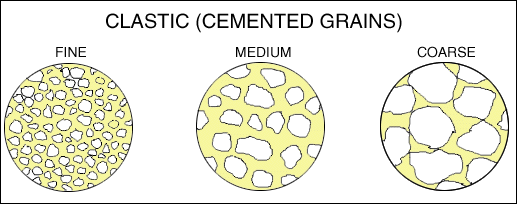
|
Information Source:  |
 Question 1: Here we have grains surrounded by a cement. How might the differences in grain size be explained? Question 1: Here we have grains surrounded by a cement. How might the differences in grain size be explained?
|
| CLASTIC ROCKS: GRAIN SIZE UNIFORMITY |
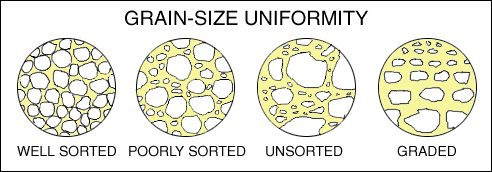
|
Information Sources:




|
 Question 1: What transportation/depositional processes or conditions result in sediment that is well sorted? Question 1: What transportation/depositional processes or conditions result in sediment that is well sorted?
 Question 2: What transportation/depositional processes or conditions result in sediment that is poorly sorted to unsorted? Question 2: What transportation/depositional processes or conditions result in sediment that is poorly sorted to unsorted?
 Question 3: What transportation/depositional processes or conditions result in sediment that is graded? Question 3: What transportation/depositional processes or conditions result in sediment that is graded?
|
|
CLASTIC ROCKS: GRAIN SHAPE |

|
Information Sources:

|
 Question 1: How do distance and duration of transport affect angularity of sediment grains? Question 1: How do distance and duration of transport affect angularity of sediment grains?
|
| CRYSTALLINE ROCKS: GRAIN SIZE |
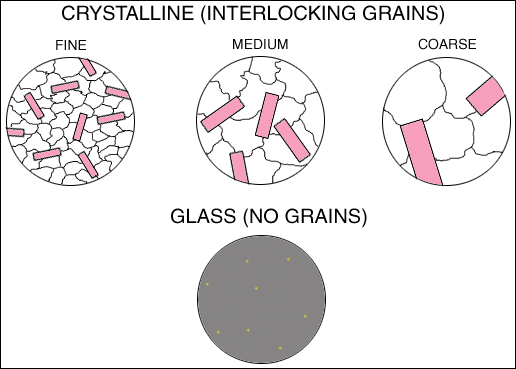
|
Information Source:  |
 Question 1: Here we have interlocking grains or no grains (glass). For rock textures with interlocking grains, how might the difference in grain size be explained? Frame your answer in terms of three formational environments (environments in which crystallization/precipitation took place): (a) solutions (b) melts (c) solids. Question 1: Here we have interlocking grains or no grains (glass). For rock textures with interlocking grains, how might the difference in grain size be explained? Frame your answer in terms of three formational environments (environments in which crystallization/precipitation took place): (a) solutions (b) melts (c) solids.
 Question 2: How may the presence of glass be explained? Question 2: How may the presence of glass be explained?
|
| CRYSTALLINE ROCKS: GRAIN SIZE UNIFORMITY |

|
Information Sources:

 Question 1: Describe a situation in nature where a melt begins to cool at one rate and then is placed in a new situation where the rate of cooling increases, and eventually results in a crystalline solid that has two distinct grain sizes. Question 1: Describe a situation in nature where a melt begins to cool at one rate and then is placed in a new situation where the rate of cooling increases, and eventually results in a crystalline solid that has two distinct grain sizes.
|
|
| CRYSTALLINE ROCKS: GRAIN SHAPE |
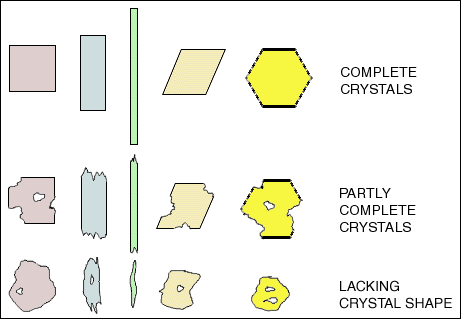
|
Information Sources:
 |
 Question 1: Does grain shape serve to distinguish between crystalline igneous, sedimentary and metamorphic rocks? Question 1: Does grain shape serve to distinguish between crystalline igneous, sedimentary and metamorphic rocks?
 Question 2: What kind of information might grain shape provide for crystalline rocks? Question 2: What kind of information might grain shape provide for crystalline rocks?
|
| GLASS ROCKS: TEXTURES |
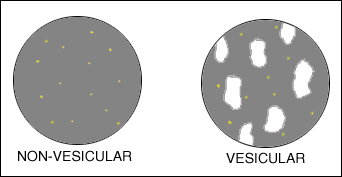
|
Information Sources:
 |
 Question 1: Under what circumstances does glass, with or without vesicular texture, form in nature? Question 1: Under what circumstances does glass, with or without vesicular texture, form in nature?
 Question 2: Where, specifically, is vesicular glass rather than non-vesicular glass likely to occur? Question 2: Where, specifically, is vesicular glass rather than non-vesicular glass likely to occur?
|
| GRAIN ORIENTATION |
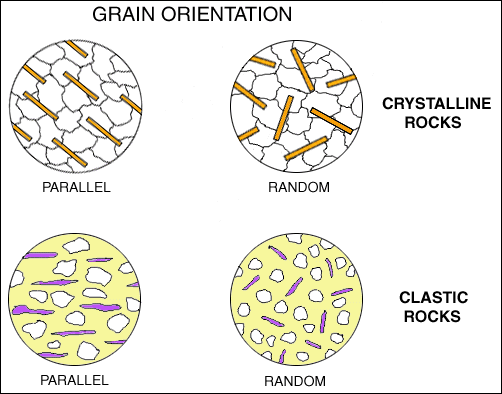
|
Information Sources:
 |
 Question 1: Briefly describe one or more natural environments in which the material out of which a rock is made may develop an oriented texture due to deposition. Is the environment igneous, sedimentary, or metamorphic? Question 1: Briefly describe one or more natural environments in which the material out of which a rock is made may develop an oriented texture due to deposition. Is the environment igneous, sedimentary, or metamorphic?
 Question 2: Briefly describe one or more natural environments in which the material out of which a rock is made may develop an oriented texture due to shaking and compaction. Is the environment igneous, sedimentary, or metamorphic? Question 2: Briefly describe one or more natural environments in which the material out of which a rock is made may develop an oriented texture due to shaking and compaction. Is the environment igneous, sedimentary, or metamorphic?
 Question 3: Briefly describe one or more natural environments in which the material out of which a rock is made may develop an oriented texture due to compression and rotation. Is the environment igneous, sedimentary, or metamorphic? Question 3: Briefly describe one or more natural environments in which the material out of which a rock is made may develop an oriented texture due to compression and rotation. Is the environment igneous, sedimentary, or metamorphic?
 Question 4: Briefly describe one or more natural environments in which the material out of which a rock is made may develop an oriented texture due to compression and selective growth. Is the environment igneous, sedimentary, or metamorphic? Question 4: Briefly describe one or more natural environments in which the material out of which a rock is made may develop an oriented texture due to compression and selective growth. Is the environment igneous, sedimentary, or metamorphic?
 Question 5: Briefly describe one or more natural environments in which the material out of which a rock is made may develop an oriented texture due to flow. Is the environment igneous, sedimentary, or metamorphic? Question 5: Briefly describe one or more natural environments in which the material out of which a rock is made may develop an oriented texture due to flow. Is the environment igneous, sedimentary, or metamorphic?
|
To check your answers and get additional hints and information, click on the link. |